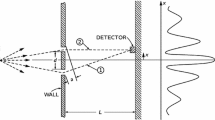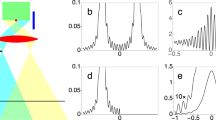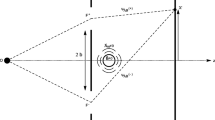Abstract
In the Aharonov-Bohm effect, electromagnetic potentials alter the two-slit interference pattern formed by an electron beam. We discuss here a curious feature of this effect, namely that, even though the interference pattern changes, none of its moments are shifted.
Similar content being viewed by others
References
Y. Aharonov and D. Bohm,Phys. Rev. 115, 485 (1959).
T. T. Wu and C. N. Yang,Phys. Rev. D 12, 3845 (1975).
S. Olariu and I. I. Popescu,Rev. Mod. Phys. 57, 339 (1985).
M. D. Semon and J. R. Taylor,Nuovo Cimento B 97, 25 (1987).
M. D. Semon and J. R. Taylor,Nuovo Cimento B 100, 389 (1987).
I. S. Gradshteyn and I. M. Ryzhik,Tables of Integrals, Series, and Products (Academic Press, New York, 1965).
W. Feller,An Introduction to Probability Theory and Its Applications, Vol. II, 2nd ed. (Wiley, New York, 1971), p. 227.
Y. Aharonov, H. Pendleton, and E. Peterson,Int. J. Theor. Phys. 2, 213 (1969).
Author information
Authors and Affiliations
Rights and permissions
About this article
Cite this article
Semon, M.D., Taylor, J.R. The Aharonov-Bohm effect: Still a thought-provoking experiment. Found Phys 18, 731–740 (1988). https://doi.org/10.1007/BF00734153
Received:
Issue Date:
DOI: https://doi.org/10.1007/BF00734153




